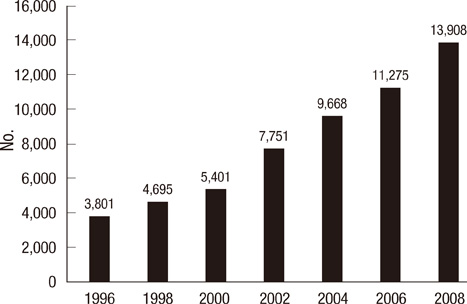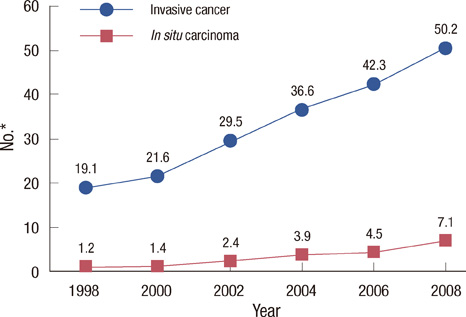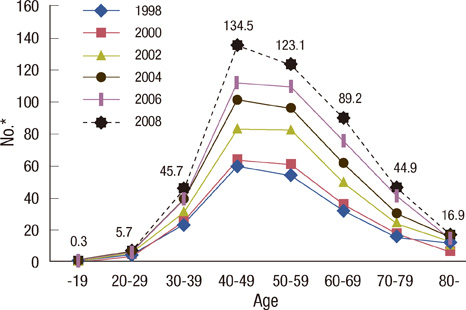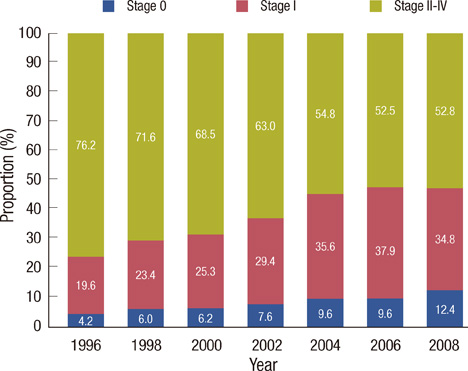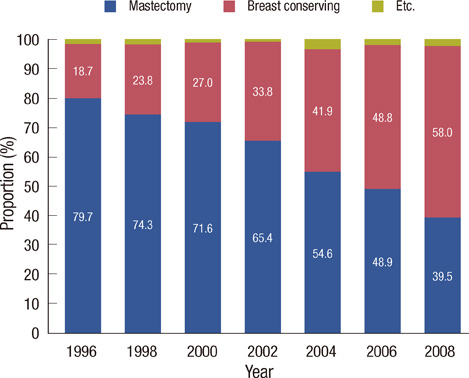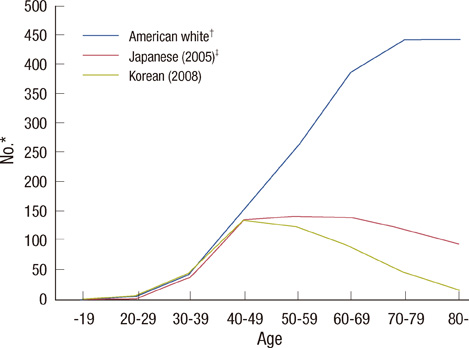J Breast Cancer.
2011 Sep;14(3):229-236.
Nation-Wide Korean Breast Cancer Data from 2008 Using the Breast Cancer Registration Program
- Affiliations
-
- 1Department of Surgery, Ajou University School of Medicine, Suwon, Korea. drjys@ajou.ac.kr
- 2Department of Surgery, Asan Medical Center, University of Ulsan College of Medicine, Seoul, Korea.
- 3Department of Surgery, Yeungnam University College of Medicine, Daegu, Korea.
- 4Department of Surgery, Gachon University of Medical and Science, Incheon, Korea.
- 5Department of Surgery, Inha University College of Medicine, Incheon, Korea.
Abstract
- PURPOSE
Since 1996, the Korean Breast Cancer Society has collected nation-wide breast cancer data and analyzed the data using their online registration program biannually. The purpose of this study was to evaluate the characteristics of Korean breast cancer from 2008 and examine chronological based patterns.
METHODS
Data were collected from 38 medical schools (67 hospitals), 20 general hospitals, and 10 private clinics. The data on the total number, gender, and age distribution were collected through a questionnaire as well as other detailed data analyzed via the online registration program.
RESULTS
In 2008, there were 13,908 patients who were newly diagnosed with breast cancer. The crude incidence rate of female breast cancer was 57.3 among 100,000 and the median age was 49 years. The age distribution had not changed since the initial survey; however the proportion of postmenopausal patients had increased and median age was older than the past. In staging distribution, the proportion of early breast cancer (stage 0, I) was 47.2% with, breast-conserving surgery performed in 58% and mastectomy in 39.5%.
CONCLUSION
Compared to past data, the incidence of breast cancer in Korea continues to rise. Furthermore, the proportion of those detected by screening and breast conservation surgery has increased remarkably. To understand the patterns of Korean breast cancer, the nation-wide data should continuously investigated.
Keyword
MeSH Terms
Figure
Reference
-
1. Korean Breast Cancer Society. Korean breast cancer data of 1996. J Korean Surg Soc. 1998. 55:621–635.2. Korean Breast Cancer Society. Korean breast cancer data of 1997. J Korean Cancer Assoc. 1999. 31:1202–1209.3. The Korean Breast Cancer Society. Korean breast cancer data of 1998. J Korean Breast Cancer Soc. 1999. 2:111–127.4. Korean Breast Cancer Society. Clinical characteristics of breast cancer patients in Korea in year 2000. J Korean Breast Cancer Soc. 2002. 5:217–224.5. The Korean Breast Cancer Society.Nationwide Korean breast cancer data of 2002. J Korean Breast Cancer Soc. 2004. 7:72–83.6. The Korean Breast Cancer Society. Nationwide Korean breast cancer data of 2004 using breast cancer registration program. J Breast Cancer. 2006. 9:151–161.7. SEER cancer statistics review, 1975-2007. National Cancer Institute. Accessed September 6th, 2010. http://seer.cancer.gov/csr/1975_2007.8. Rossouw JE, Anderson GL, Prentice RL, LaCroix AZ, Kooperberg C, Stefanick ML, et al. Risks and benefits of estrogen plus progestin in healthy postmenopausal women: principal results from the Women's Health Initiative randomized controlled trial. JAMA. 2002. 288:321–333.
Article9. Ravdin PM, Cronin KA, Howlader N, Berg CD, Chlebowski RT, Feuer EJ, et al. The decrease in breast-cancer incidence in 2003 in the United States. N Engl J Med. 2007. 356:1670–1674.
Article10. Kumle M. Declining breast cancer incidence and decreased HRT use. Lancet. 2008. 372:608–610.
Article11. Parkin DM. Is the recent fall in incidence of post-menopausal breast cancer in UK related to changes in use of hormone replacement therapy? Eur J Cancer. 2009. 45:1649–1653.
Article12. Katalinic A, Rawal R. Decline in breast cancer incidence after decrease in utilisation of hormone replacement therapy. Breast Cancer Res Treat. 2008. 107:427–430.
Article13. Allemand H, Seradour B, Weill A, Ricordeau P. Decline in breast cancer incidence in 2005 and 2006 in France: a paradoxical trend. Bull Cancer. 2008. 95:11–15.14. Canfell K, Banks E, Moa AM, Beral V. Decrease in breast cancer incidence following a rapid fall in use of hormone replacement therapy in Australia. Med J Aust. 2008. 188:641–644.
Article15. GLOBOCAN 2008 v1.2, Cancer incidence and mortality worldwide: IARC CancerBase No. 10. International Agency for Research on Cancer. Accessed September 6th, 2010. http://globocan.iarc.fr.16. Cancer statistics in Japan, 2008. National Cancer Center (Japan). Accessed September 8th, 2010. http://ganjoho.ncc.go.jp/public/statistics/backnumber/2008_en.html.
- Full Text Links
- Actions
-
Cited
- CITED
-
- Close
- Share
- Similar articles
-
- Nationwide Korean Breast Cancer Data of 2004 Using Breast Cancer Registration Program
- Erratum: Nation-Wide Korean Breast Cancer Data from 2008 Using the Breast Cancer Registration Program
- The Highligts of 28th Annual Meeting of San Antonio Breast Cancer Symposium
- Surgery of Breast Cancer during the Last 5 Years: More Sophisticated and Specialized?
- Clinical characteristics of Korean breast cancer patients in 1998. The Korean Breast Cancer Society

